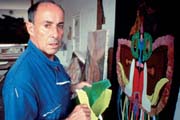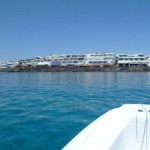Cesar Manrique in Lanzarote

Cesar Manrique (1919-1992) was born in Arrecife, Lanzarote, an island on which his career has left indelible marks.
After completing his studies at the Academy of Fine Arts of San Fernando in Madrid (city in which he lived between 1945 and 1964), he often exhibits his paintings within as much as without Spain. He participates in the XXVIII and XXX biennial exhibition of Venecia (1955 and 1960) and at the III Spanish-American biennial exhibition of La Habana (1955). In the early 50’s he introduces himself in the non-figurative art and he investigates the qualities of materials as to turn them into the main characters of his compositions. He thus becomes connected with other Spanish artists such as Antoni Tàpies, Lucio Muñoz, Manuel Millares…- to the informal movement of those years.
He travels through various parts of the world, and in 1964 he moves to New York. The direct knowledge of American abstract expressionism, pop art, new sculpture and kinetic art, provided him a visual culture central to his later creative career. In New York, he individually exhibited on three occasions in 1966, 1967 and 1969 – in the Catherine Viviano gallery.
In 1966, he is definitively back to Lanzarote. In the island, which then began its tourism development, he promotes a model of intervention in the territory on key factors such as sustainability which sought to safeguard the natural heritage and cultural insularity; a model that was instrumental in the declaration of Lanzarote as a Biosphere Reserve by UNESCO in 1993.
In parallel with the commitment to the island’s territory, Manrique opened his creative work to other art forms. Thus, he developed a new aesthetic idea, which he named art-nature/nature-art, which he managed to specify in his space interventions, a unique example of public art in Spain: Jameos del Agua, his Tahiche home -nowadays seat of the Cesar Manrique Foundation-, Mirador del Rio, Cactus Garden, and so on.
In addition to his interventions in Lanzarote, he devised various proposals on other islands -Martianez Coast, Puerto de la Cruz, Tenerife; El Mirador Palmarejo, La Gomera; Mirador de La Pena, El Hierro. Outside the Canarian Archipelago he intervened at: Ceuta-Mediterranean Maritime Park, Madrid -Madrid-2 shopping center, La Vaguada-etc. These are interventions, mainly public works -viewpoints, gardens, fitting of degraded sites, alteration of the coast …- where he maintains a respectful dialogue with the natural environment and balances architectural values of local tradition with modern conceptions.
Cultivator of various creative languages: sculpture, paintings, urbanism, public art…- an evident will of intregation with the natural enviroment lies within the joint collection of his work. Totalizing and sincretic purpose -total art, in his words- that he made explicit in his designs of public spaces. An effort of harmonization, in short, that not only makes reference to his passion for beauty, but also for life.












